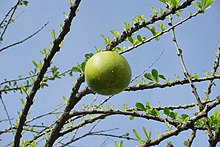മജപഹിത്
മജപഹിത് സാമ്രാജ്യം Majapahit Empire | |||||||||||
|---|---|---|---|---|---|---|---|---|---|---|---|
| 1293–1527 | |||||||||||
Surya Majapahit[i] കുലചിഹ്നം
| |||||||||||
![Extent of Majapahit influence based on the Nagarakretagama; the notion of such Javanese depictions is considered conceptual.[1]](http://upload.wikimedia.org/wikipedia/commons/thumb/7/71/Majapahit_Empire.svg/250px-Majapahit_Empire.svg.png) Extent of Majapahit influence based on the Nagarakretagama; the notion of such Javanese depictions is considered conceptual.[1] | |||||||||||
| തലസ്ഥാനം | Majapahit, Wilwatikta (modern Trowulan) | ||||||||||
| പൊതുവായ ഭാഷകൾ | Old Javanese (main), Sanskrit (religious) | ||||||||||
| മതം | Hinduism, Buddhism, Kejawen, Animism | ||||||||||
| ഗവൺമെൻ്റ് | Monarchy | ||||||||||
• 1295–1309 | Raden Wijaya | ||||||||||
• 1334-1389 | Hayam Wuruk | ||||||||||
• 1498–1527 | Girindrawardana | ||||||||||
| Mahapatih | |||||||||||
• c. 1336–1364 | Gajah Mada | ||||||||||
| ചരിത്രം | |||||||||||
• Coronation | 10 November[2] 1293 | ||||||||||
• Demak takeover | 1527 | ||||||||||
| നാണയവ്യവസ്ഥ | Native gold and silver coins, Kepeng (copper coins imported from China and later produced locally)[3] | ||||||||||
| |||||||||||
| ഇന്ന് ഇത് ഈ രാജ്യങ്ങളുടെ ഭാഗമാണ്: | |||||||||||
Part of a series on the |
|---|
| Indonesia പ്രദേശത്തിന്റെ ചരിത്രം |
   |
| Timeline |
1293 മുതൽ 1500 വരെ ജാവ ആസ്ഥാനമായി നിലനിന്നിരുന്ന സാമ്രാജ്യമായിരുന്നു മജപഹിത് സാമ്രാജ്യം(Majapahit Empire Javanese: ꦏꦫꦠꦺꦴꦤ꧀ꦩꦗꦥꦲꦶꦠ꧀ Karaton Majapahit, Indonesian: Kerajaan Majapahit) തെക്കുകിഴക്കേ ഏഷ്യയിലെ ഒരു സമുദ്രസാമീപ്യ സാമ്രാജ്യം ( thalassocracy) ആയിരുന്ന ഈ സാമ്രാജ്യം അതിന്റെ അത്യുന്നതാവസ്ഥയിൽ എത്തിയത് 1350-1389 കാലഘട്ടത്തിലെ ഭരിച്ചിരുന്ന ഹയംവുറുക്കിന്റെ (Hayam Wuruk, രാജശേഖരൻ) കാലത്തായിരുന്നു. അദ്ദേഹത്തിന്റെ നേട്ടങ്ങൾക്ക്പിന്നിൽ പ്രവർത്തിച്ചത് പ്രഗൽഭനായ പ്രധാനമന്ത്രി ഗജമാധ ആയിരുന്നു.(Gajah Mada). 1365-ൽ എഴുതപ്പെട്ട നഗരക്രേതഗമ(Nagarakretagama ദേശവർണ്ണന) അനുസരിച്ച്, സുമാത്ര മുതൽ ന്യൂ ഗിനിയ വരെ വ്യാപിച്ചുകിടന്നിരുന്ന 98 സാമന്തരാജ്യങ്ങൾ(tributaries) ഉൾക്കൊള്ളുന്നതായിരുന്നു മജപഹിത് [4](p87)[5] ഇന്നത്തെ ഇന്തോനേഷ്യ, സിംഗപ്പൂർ, മലേഷ്യ, ബ്രൂണൈ, ദക്ഷിണ തായ്ലന്റ്, സുളു ദ്വീപസമൂഹങ്ങൾ കിഴക്കൻ തിമോർ, മജപഹിത് സാമ്രാജ്യത്തിന്റെ യഥാർഥ സ്വാധീനം എത്രയോളമായിരുന്നുവെന്ന് ഇന്നും ചരിത്രകാരന്മാരുടെ ഇടയിലെ ഒരു പഠനവിഷയമാൺ*.[6][7]
ഈ പ്രദേശത്തെ ഏറ്റവും വലിയ സാമ്രാജ്യങ്ങളിൽ അവസാനത്തേതായിരുന്ന മജപഹിത് സാമ്രാജ്യം ഇന്തോനേഷ്യയുടെയും തെക്ക് കിഴക്കൻ ഏഷ്യയിലേയും ഏറ്റവും മഹത്തായതായി കണക്കാക്കപ്പെടുന്നു.[8] (p19)[9] ആധുനിക ഇന്തോനേഷ്യയുടെ അതിർത്തികൾക്ക് പുറത്തേക്കും വ്യാപിച്ചിരുന്ന ഈ സാമ്രാജ്യത്തിന്റെ സ്വാധീനത്തെക്കുറിച്ച് പഠനങ്ങൾ നടക്കുന്നുണ്ട്.[10][11]
പേരിനു പിന്നിൽ[തിരുത്തുക]

ജാവയിലെ ഗ്രാമങ്ങൾക്ക് അവിടെ സുലഭമായതോ ശ്രദ്ധേയമായതോ ആയ വൃക്ഷങ്ങളുറ്റെ പേർ നൽകുന്ന സമ്പ്രദായമുണ്ടായിരുന്നു. മജപഹിതിന്റെ ആദ്യ തലസ്ഥാനമായിരുന്ന ട്രൊവുലാനു സമീപം നാരായണ സംഗമവിജയ (Raden Wijaya) രാജാവിന്റെ വനങ്ങളിൽ കൂവളമരങ്ങൾ ഉണ്ടായിരുന്നു, ജാവനീസ് ഭാഷയിൽ കൂവളത്തിന്റെ (ശാസ്ത്രീയ നാമം: ഏയ്ഗ്ളി മെർമെലോസ്, Aegle marmelos ) പേരായ മജ (maja) എന്ന വാക്കിൽനിന്നുമാണു ഈ സാമ്രാജ്യത്തിന്റെ പേർ വന്നത് [12]
ചരിത്രം[തിരുത്തുക]
1290-ൽ സുമാത്രയിലെ മലയൻ രാജവംശത്തിനെ(Melayu Kingdom) പരാജയപ്പെടുത്തിയതിനു ശേഷം സിംഹശ്രീ (Singhasari)[13] ഈ പ്രദേശത്തിലെ ഏറ്റവും ശക്തമായ സാമ്രാജ്യമായി. മംഗോൾ സാമ്രാജ്യത്തിലെ കുബ്ലായി ഖാൻ കപ്പം നൽകണമെന്നാവശ്യപ്പെട്ട് സന്ദേശവാഹകരെ അയച്ചെങ്കിലും സിംഹശ്രീയിലെ അവസാനത്തെ രാജാവായ കീർത്തനഗര (ശിവബുദ്ധ) രാജാവ് ദൂതനെ അപമാനിക്കുകയും ഖാനെ വെല്ലുവിളിക്കുകയും ചെയ്തു. 1293-ൽ കുബ്ലായി ഖാൻ ആയിരത്തോളം കപ്പലുകൾ ഈ പ്രദേശത്തെലേക്കയച്ചു, കുബ്ലായി ഖാൻ അയച്ച പട്ടാളക്കാരുടെ എണ്ണം ഇരുപതിനായിരത്തിനും മുപ്പതുനായിരത്തിനുമിടയിൽ ഇടയിൽ ആയിരുന്നു. [14]
ഈ ആക്രമണത്തെ നേരിടാൻ കീർത്തനഗര രാജാവ് തന്റെ സൈന്യത്തിനെ സുമാത്രയിലേക്ക് അയച്ച. അവസരം മുതലെടുത്ത് കേദിരിയിലെ(Kediri) സാമന്തനായ ജയകട്വാങ്(Jayakatwang), കീർത്തനഗരനെതിരെ പടയൊരുക്കം നടത്തി. മദുര ദ്വീപിലെ ആര്യ വീരരാജനും ജയകട്വാങിനെ യുദ്ധത്തിൽ സഹായിച്ചു[15]:199 .
കേദിരിയിലെ സൈന്യം വടക്കുനിന്നും തെക്കുനിന്നും ഏകദേശം ഒരേ സമയം ആക്രമണം നടത്തി, വടക്കുനിന്നുമുള്ള ആക്രമണത്തെക്കുറിച്ചുമാത്രം അറിവുണ്ടായിരുന്ന കീർത്തനഗര രാജാവ് തന്റെ പുത്രീഭർത്താവിന്റെ (നാരായണ സംഗ്രാമവിജയ) നേതൃത്വത്തിൽ ഒരു സൈന്യത്തെ അയച്ചു. വടക്കുഭാഗത്തെ ആക്രമണം അടിച്ചമർത്തിയെങ്കിലും തെക്ക്ഭാഗത്ത് നടന്ന അപ്രതീക്ഷിതമായ ആക്രമണത്തിൽ തലസ്ഥാനം കീഴടക്കിയ ജയകട്വാങ് കീർത്തനഗരനെ വധിച്ചു. സംഗ്രാമവിജയക്ക് ജയകട്വാങിനെതിരെ യുദ്ധം ചെയ്തെങ്കിലും ജയിക്കാൻ സാധിച്ചില്ല. ജയകട്വാങ് പിന്നീട് സംഗ്രാമവിജയയെ ട്രൊവുലാൻ പ്രദേശത്തിൽ പുതിയ ഒരു രാജ്യം നിർമ്മിക്കാൻ അനുവദിച്ചു. എന്നാൽ മംഗോളിയൻ സൈന്യം എത്തിയപ്പോൾ സംഗ്രാമവിജയ ജയകട്വാങിനെതിരെ പോരാടാൻ മംഗോളിയൻ സൈന്യത്തിന്റെ സഹായിച്ചു.
പിന്നീട് ജാവയിൽ നിന്നും തന്റെ സഖ്യകക്ഷികളെ പിൻവലിച്ച സംഗ്രാമവിജയ, മംഗോളിയൻ സൈന്യത്തിനെതിരെ നടന്ന അപ്രതീക്ഷിത ആക്രമണം നടത്തി. മൺസൂൺ കാലത്തെ അനുകൂലമായ കാറ്റുണ്ടായതിനാൽ .മംഗോളിയൻ സൈന്യം പിൻവാങ്ങി.
കീർത്തനഗര രാജാവ്[തിരുത്തുക]

ശകവർഷം 1215-ലെ കാർത്തികമാസം പതിനഞ്ചാം തീയതിയാൺ* സംഗ്രാമവിജയ രാജാവ് കിരീടധാരണം നടത്തിയത്. (നവംബർ 10 1293).[2] കീർത്തനഗര രാജാവിന്റെ മറ്റു പുത്രിമാരെ വിവാഹം കഴിക്കുകയും ചെയ്തു (ആദ്യഭാര്യയായ ത്രിഭുവനേശ്വരി സഹോദരിമാരായ പ്രജ്ഞാതപരമിത, നരേന്ദ്രാദുഹിത ഗായത്രി രാജപത്നി) പിന്നീട് സുമാത്രയിലെ ധർമാശ്രയ രാജകുമാരിയായ ഇന്ദ്രേശ്വരിയെയും സംഗ്രാമവിജയ വിവാഹം ചെയ്തു. 1309-ൽ മരണമടയുന്നതുവരെ സംഗ്രാമവിജയ രാജാവ് മജപഹിത് ഭരിച്ചു.
ജയനഗര രാജാവ്[തിരുത്തുക]

സംഗ്രാമവിജയക്ക് ഇന്ദ്രേശ്വരിയിലുണ്ടായ പുത്രനായ ജയനഗര രാജാവ് (ശ്രീ മഹാരാജ വീരലന്തഗോപാല ശ്രീ സുന്ദരപാണ്ഡ്യ ദേവ അധീശ്വര, അഥവാ സുന്ദരപാണ്ഡ്യദേവാധീശ്വര വിക്രമോത്തുംഗദേവ , കാല ഗെമെറ്റ് എന്നും അറിയപ്പെട്ടിരിന്നു) 1309 മുതൽ 1328 വരെ ഭരിച്ചു.
അവലംബം[തിരുത്തുക]
- ↑ Hall, D. G. E. (1965). "Problems of Indonesian Historiography". Pacific Affairs. 38 (3/4): 353. doi:10.2307/2754037. JSTOR 2754037.
- ↑ 2.0 2.1 Mahandis Y. Thamrin (September 2012). "10 November, Hari Berdirinya Majapahit" (in Indonesian). National Geographic Indonesia. Archived from the original on 2015-05-26. Retrieved 27 May 2015.
{{cite web}}: CS1 maint: unrecognized language (link) - ↑ Ooi, Keat Gin, ed. (2004). Southeast Asia: a historical encyclopedia, from Angkor Wat to East Timor (3 vols). Santa Barbara: ABC-CLIO. ISBN 978-1576077702. OCLC 646857823. Archived from the original on 2016-08-08. Retrieved 2018-11-04.
- ↑ Cribb, Robert (2013). Historical Atlas of Indonesia. Routledge. ISBN 9781136780578.
- ↑ Majapahit Overseas Empire, Digital Atlas of Indonesian History
- ↑ Wood, Michael. "The Borderlands of Southeast Asia Chapter 2: Archaeology, National Histories, and National Borders in Southeast Asia" (PDF): 36. Archived from the original (PDF) on 5 മേയ് 2015. Retrieved 4 മേയ് 2015.
{{cite journal}}: Cite journal requires|journal=(help); Unknown parameter|deadurl=ignored (|url-status=suggested) (help) - ↑ "Indonesia, The Majapahit Era". Britannica.
- ↑ Ricklefs, Merle Calvin (1993). A history of modern Indonesia since c. 1300 (2nd ed.). Stanford University Press / Macmillans. ISBN 9780804721950.
- ↑ Sita W. Dewi (9 April 2013). "Tracing the glory of Majapahit". The Jakarta Post. Retrieved 5 February 2015.
- ↑ Prapantja, Rakawi, trans. by Theodore Gauthier Pigeaud, Java in the 14th Century, A Study in Cultural History: The Negara-Kertagama by Rakawi Prapanca of Majapahit, 1365 AD (The Hague, Martinus Nijhoff, 1962), vol. 4, p. 29. 34
- ↑ G.J. Resink, Indonesia’s History Between the Myths: Essays in Legal History and Historical Theory (The Hague: W. van Hoeve, 1968), p. 21.
- ↑ The Brunei Museum journal, Volume 4, Issue 1 – Page 192
- ↑ Spuler, Bertold; F.R.C Bagley (1981). The Muslim world: a historical survey, Part 4. Brill Archive. p. 252. ISBN 9789004061965.
- ↑ Weatherford, Jack (2004), Genghis khan and the making of the modern world, New York: Random House, p. 239, ISBN 0-609-80964-4
- ↑ Cœdès, George (1968). The Indianized states of Southeast Asia. University of Hawaii Press. ISBN 9780824803681.
കുറിപ്പുകൾ[തിരുത്തുക]
- ↑ Surya Majapahit (the Sun of Majapahit) is the emblem commonly found in Majapahit ruins. It served as the symbol of the Majapahit empire.

